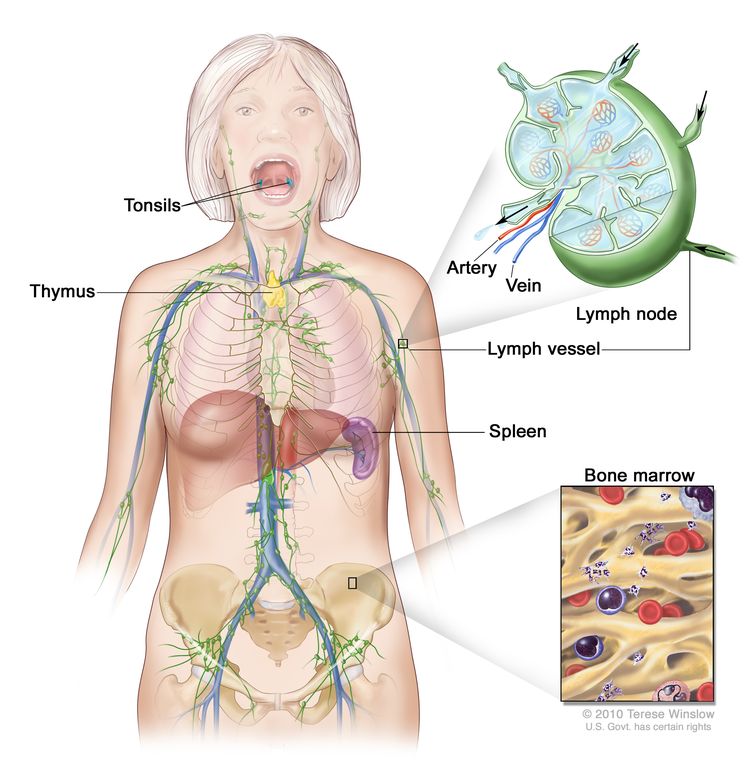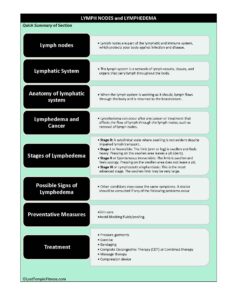Lymphedema & Cancer
Your Body is Your Temple
Research, Resources & Education
Table of Contents
Lymphedema is a condition that occurs when the lymphatic system, which is responsible for removing excess fluids and waste products from the body, is unable to function properly. As a result, there is an abnormal accumulation of protein-rich fluid in one specific area, leading to uncomfortable swelling and discomfort. It can occur due to a variety of reasons, such as surgery, radiation therapy, infection, injury, or as a result of a genetic predisposition.
Information and pictures from National Cancer Institute unless otherwise specified
Lymph Nodes and the Lymphatic System

Lymph Nodes
Lymph nodes are part of the lymphatic and immune system, which protects your body against infection and disease.
- Lymph nodes are small, round organs that are clustered in many areas of the body, such as the underarm.
- It consists of a network of vessels and organs that contains lymph, a clear fluid that carries infection-fighting white blood cells as well as fluid and waste products from the body’s cells and tissues.
- Cancer cells can spread to lymph nodes and other parts of the body through lymph vessels.
- In a person with cancer, lymph can also carry cancer cells that have broken off from the main tumor.
- Once lymph nodes are removed, they will be checked for cancer.
- Knowing whether cancer is in the underarm lymph nodes can help the doctor decide if you need any treatment in addition to surgery.
Lymphatic System
The lymph system is a network of lymph vessels, tissues, and organs that carry lymph throughout the body.
- The parts of the lymph system that play a direct part in lymphedema include the following:
- Lymph: Colorless, watery fluid that travels through the lymph vessels and carries T and B lymphocytes.
- Lymphocytes are a type of white blood cell.
- Lymph vessels: A network of thin tubes that collect lymph from different parts of the body and return it to the bloodstream.
- Lymph nodes: Small, bean-shaped structures that filter lymph and store white blood cells that help fight infection and disease.
- Lymph nodes are found along a network of lymph vessels throughout the body.
- Groups of lymph nodes are found in the neck, underarm, mediastinum, abdomen, pelvis, and groin..
- Lymph (clear fluid) and lymphocytes travel through the lymph vessels and into the lymph nodes where the lymphocytes destroy harmful substances.
- The lymph enters the blood through a large vein near the heart.
- The spleen, thymus, tonsils, and bone marrow are also part of the lymph system but do not play a direct part in lymphedema.
Anatomy of Lymphatic System
When the lymph system is working as it should, lymph flows through the body and is returned to the bloodstream.
- Fluid and plasma leak out of the capillaries (smallest blood vessels) and flow around body tissues so the cells can take up nutrients and oxygen.
- Some of this fluid goes back into the bloodstream.
- The rest of the fluid enters the lymph system through tiny lymph vessels.
- These lymph vessels pick up the lymph and move it toward the heart.
- The lymph is slowly moved through larger and larger lymph vessels and passes through lymph nodes where waste is filtered from the lymph.
- The lymph keeps moving through the lymph system and collects near the neck, then flows into one of two large ducts:
- The right lymph duct collects lymph from the right arm and the right side of the head and chest.
- The left lymph duct collects lymph from both legs, the left arm, and the left side of the head and chest.
- These large ducts empty into veins under the collarbones, which carry the lymph to the heart, where it is returned to the bloodstream.
When part of the lymph system is damaged or blocked, fluid cannot drain from nearby body tissues.
- Fluid builds up in the tissues and causes swelling/edema.
Videos on the Lymphatic System, Lymphedema, Cancer and Stages
YouTube Videos that help explain the lymphatic system, lymphedema, cancer and staging.
Disclaimer:
This is for research only and Lost Temple Fitness & Cancer does not endorse any video presented on this website.
It is advised that you ALWAYS CHECK WITH YOUR PHYSICIAN for a proper diagnosis and treatment plan.
Lymphedema, Cancer and Stages
Lymphedema
Lymphedema is swelling caused by excess protein-rich lymph trapped within the interstitium and subcutaneous tissues.
- This is caused by dysfunction of the lymphatic system or pathology.
- Lymphedema occurs when the lymph system is damaged or blocked.
- Fluid builds up in soft body tissues and causes swelling.
- It is a common problem that may be caused by cancer and cancer treatment.
- Lymphedema usually affects an arm or leg, but it can also affect other parts of the body.
- Lymphedema can cause long-term physical, psychological, and social problems for patients.
Lymphedema and Cancer
Lymphedema can occur after any cancer or treatment that affects the flow of lymph through the lymph nodes, such as removal of lymph nodes.
- It may develop within days or many years after treatment.
- Most lymphedema develops within three years of surgery.
Risk factors for lymphedema include the following:
- Removal and/or radiation of lymph nodes in the underarm, groin, pelvis, or neck.
- The risk of lymphedema increases with the number of lymph nodes affected.
- There is less risk with the removal of only the sentinel lymph node (the first lymph node in a group of lymph nodes to receive lymphatic drainage from the primary tumor).
- Being overweight or obese.
- Slow healing of the skin after surgery.
- A tumor that affects or blocks the left lymph duct or lymph nodes or vessels in the neck, chest, underarm, pelvis, or abdomen.
- Scar tissue in the lymph ducts under the collarbones, caused by surgery or radiation therapy.
- Lymphedema often occurs in breast cancer patients who had all or part of their breast removed and axillary (underarm) lymph nodes removed. (See below)
- Lymphedema in the legs may occur after surgery for uterine cancer, prostate cancer, lymphoma, or melanoma. It may also occur with vulvar cancer or ovarian cancer.
- Lymphedema occurs frequently in patients with cancers of the head and neck due to high-dose radiation therapy and combined surgery.
Lymphedema and Breast Cancer
Lymphedema is swelling caused by a build-up of lymph. You may have this type of swelling in the hand, arm, chest, or back on the side of your body where lymph nodes were removed by breast cancer surgery or damaged by radiation therapy.
Some important facts to know about lymphedema are:
- Lymphedema can show up soon after surgery.
- Lymphedema can show up months or years after cancer treatment is over.
- Lymphedema might develop after an insect bite, minor injury, or burn on the arm where lymph nodes were removed or damaged.
- Lymphedema can cause pain and other problems.
Stages of Lymphedema
- Stage 0: A subclinical state where swelling is not evident despite impaired lymph transport.
- This stage may exist for months or years before edema becomes evident.
- Stage I or Reversible: The limb (arm or leg) is swollen and feels heavy.
- Pressing on the swollen area leaves a pit (dent).
- This stage of lymphedema may diminish with elevation.
- Subjective complaints are common.
- Stage II or Spontaneous irreversible: The limb is swollen and feels spongy.
- Pressing on the swollen area does not leave a pit.
- A condition called tissue fibrosis may develop and cause the limb to feel hard.
- Stage III or Lymphostatic elephantiasis: This is the most advanced stage.
- The swollen limb may be very large.
- Stage III lymphedema rarely occurs in breast cancer patients.
Possible Signs of Lymphedema
Other conditions may cause the same symptoms. A doctor should be consulted if any of the following problems occur:
- Swelling of an arm or leg, which may include fingers and toes.
- A full or heavy feeling in an arm or leg.
- A tight feeling in the skin.
- Trouble moving a joint in the arm or leg.
- Thickening of the skin, with or without skin changes such as blisters or warts.
- A feeling of tightness when wearing clothing, shoes, bracelets, watches, or rings.
- Itching of the legs or toes.
- A burning feeling in the legs.
- Trouble sleeping.
- Loss of hair.
Disclaimer: The information in this book/website is for educational purposes only and has been obtained through research, publications and personal experience, and shall not be liable for incorrect information. Any mentioned publications or websites does not imply endorsement. As this industry is ever changing, I urge readers to confirm the information contained in this book/website. The author will not be liable for any injuries sustained from practicing techniques taught or for any typographical errors or omissions.
It is advised that you always check with your medical doctor or physical therapist before starting an exercise program or change in diet.
|
Information and pictures from National Cancer Institute unless otherwise specified |




